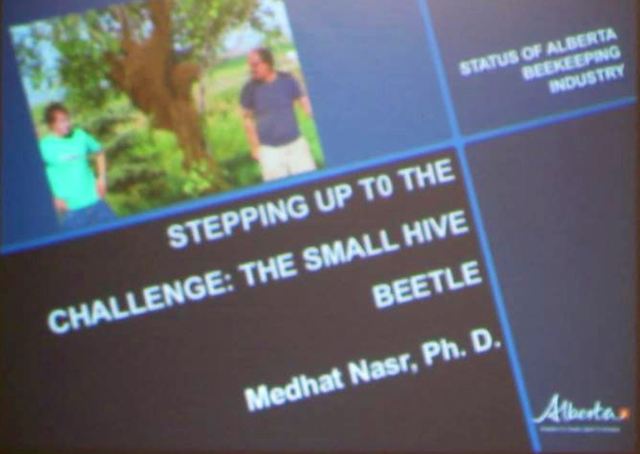
Medhat Nasr at the Calgary Bee Club
A couple of nights ago, Alberta’s chief apiculturist spoke at our local (Calgary) bee club meeting. Close to 150 people turned out to hear Dr Medhat Nasr give us a recap on the status of Alberta beekeeping and the status of the hive beetle in Canada.
There was plenty of good news in Medhat’s talk. Alberta beekeeping is thriving with more colonies (296,000) than there have ever been in our history. That’s more than twice the number of hives as there were back in 1987, according to provincial statistics. And production is high – the province-wide average was 145 pounds of honey per colony in 2015. The average would have been higher, if the 50,000 or so colonies kept for pollination weren’t counted – pollinating hives aren’t used to produce honey crops. Still, I’ll take 145 pounds per hive – it’s better than Britain’s 30 lb average, or the typical 60 pounds per hive gathered in the USA. Colony count in Alberta is growing, production is high, and wintering has been good for the past several years, with close to just 10% losses.
However, Medhat Nasr, Alberta’s provincial apiculturist, did have some potentially troubling news for beekeepers here. After running through the stats on production and after briefly talking about the free downloadable bee-health app his department created, Medhat’s Wednesday evening talk switched to the appearance of hive beetles in British Columbia, a Canadian province that shares a border (and a ridge of Rocky Mountains) with Alberta.

For those not familiar with the fifth horsemen of beekeeping doom* (or the Fifth Beatle, as I’ve heard the small hive beetle called), here’s what you might get when you open your hive and its got the beetles: slime and wiggly worms. Sometimes the only thing a beekeeper can do to stop a serious infestation is to burn everything. The fruit-sucking, honey-slurping creatures can multiply by the thousands with ugly, smelly results.

Small hive beetle damage.
We correctly associate the small hive beetle with sloppy beekeeping in hot humid climates, so we are liable to become complacent on Alberta’s dry prairies where winters are long and cold. But apiculturist Medhat cautions us to be vigilant. He described research that claims the beetles cluster among bees through cold winters and even use their little antennae to beg for food. The kindly bees, it is said, are tricked into keeping the beetles warm and plump all winter. The best offense against the slimy intruders is defensive behaviour on the part of beekeepers. A hive does not always get overrun when hive beetles are present.
A few years ago, I saw a bee outfit in Florida where just a single hive beetle was hiding under a pollen cake. The beekeeper told me that as long as his hives were strong and things were kept clean, the beetles never appeared in any big numbers.
Medhat repeated this advice – if the small hive beetle shows up in Alberta it will likely be no more than a minor nuisance among operations that are kept tidy and run efficiently. Among other beekeepers, though, some bad habits may need to change. Extracting can’t be postponed for days or weeks, for example. Such a lazy lag allows the beetles time to establish themselves in a shop and start messing with your honey. Extracting immediately has always been good policy among good beekeepers. Now it may become a necessity.
Although bees may tolerate a few beetles inside their hive, strong colonies don’t allow the numbers of beetles to grow. But in a big box with just a little cluster of bees, there are lots of places for the small hive beetle to hive. So, the usual advice of keeping strong colonies continues to be true.
Will Alberta have small hive beetles? It’s certainly possible. Just across the continental divide and over the ranges from us is the mild Pacific coast. That’s British Columbia and the beetle has been found there. We call the mild coastal area “the lower mainland” and it is where Canada’s palm trees grow. It’s also home to the city of Vancouver and some outlying towns, villages, acreages, and orchards. A few Alberta beekeepers winter their colonies in the lower mainland where the winter temps hover around plus 5 to 10 (that’s Celsius, which is around 40 to 50 F). At the same time, Alberta may linger at minus 20 for weeks. Spring arrives much earlier on the coast, bees build up, can be split for increases, and perhaps rented to orchards. By May or June, the visiting Alberta bees head back 800 kilometres (500 miles) and start on the summer honey flows on the prairies. This could result in the inadvertent arrival of small hive beetles, which were recently spotted down in the lower mainland.
Our apiary inspector and chief bee scientist wanted the Calgary and District Bee Club to be aware that the small hive beetles may be coming to a venue near us. He showed us what they look like and how to get in touch with inspectors who could come and confirm the beetles if we think we’ve got them. (Follow this link to contact the inspection department.) But Medhat also suggested that we not panic but instead keep good strong hives, operate our bees on an efficient schedule, and maintain a clean and tidy shop. If we do this, we’ll have better bee operations and we won’t have to worry too much about the exotic small hive beetles.
*The other horsemen of beekeeping doom and gloom are varroa, nosema, Africanized stock, and American foulbrood.

Pingback: Location, Location, Vocation | Bad Beekeeping Blog
Pingback: YIKES! Small Hive Beetle in Alberta | Bad Beekeeping Blog